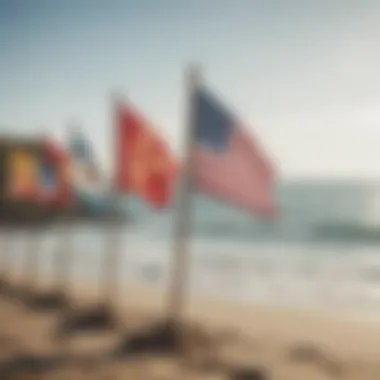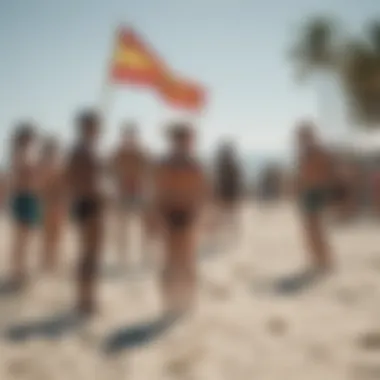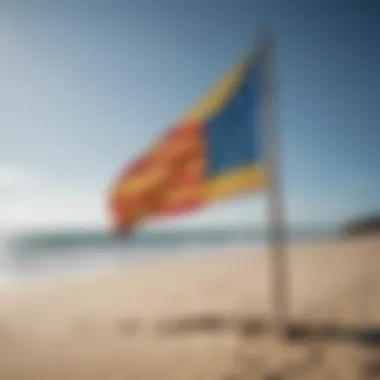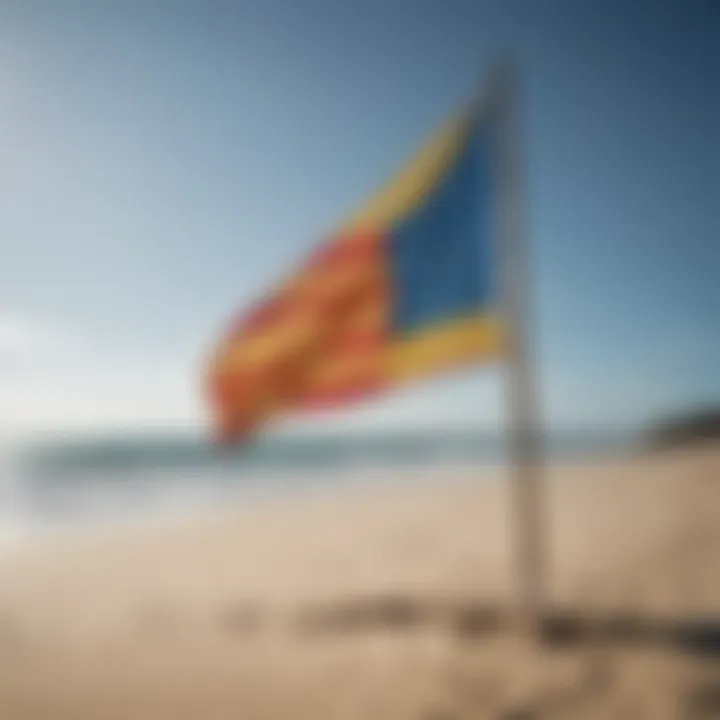Beach Flags: Importance, Varieties, and Eco-Impact


Intro
As waves crash against the shoreline and the salty breeze wafts through the air, beach flags stand tall, silently communicating vital information to every beachgoer. While many might view them as decorative, their real significance stretches far beyond mere aesthetics. These flags are crucial signposts that signal safety conditions for swimmers, surfers, and all individuals engaged in water activities. This article will explore the contemporary purpose of beach flags, their various types, the environmental implications they carry, and how they foster community welfare.
In examining these flag systems, we will navigate through differing practices across various beach locales, analyze their role in safety measures, and delve into how technology and environmental conservation are reshaping their future. Whether you're a seasoned surfer, a weekend paddleboarder, or just a family on a day out, understanding beach flags can not only enhance your water experience but also ensure safety for everyone under the sun.
Prologue to Beach Flags
The safety of all water enthusiasts—be it surfers, paddleboarders, or kitesurfers—relies heavily on a clear understanding of beach flags. These bright markers serve a far-reaching purpose beyond their vivid colors. They connect players of water sports with crucial safety information about the conditions of the beach and the ocean. Grappling with the sometimes unpredictable nature of these environments, it's essential to appreciate what each flag symbolizes. A single glance at a flag can mean the difference between a day of fun and a perilous situation.
By delving into beach flags, we also uncover a rich narrative spanning back decades. The evolution of these signals reflects not just changing safety practices but also a growing understanding of oceanic hazards. This historical perspective aids water sport enthusiasts in grasping the importance of these indicators and respecting them with certainty.
As we move deeper into the article, we’ll detail the significance and diverse types of beach flags, not to mention their impact on the environment and our community. This knowledge can foster heightened awareness and responsibility among beachgoers, who, in turn, can contribute to a safe and enjoyable atmosphere at coastal locations.
Definition of Beach Flags
Beach flags are visual signals used along coastlines to communicate water conditions to beachcombers and water sport participants. Their meaning is codified, often standardized, and can vary between regions but generally represents safety measures regarding swimming and surfing conditions.
These flags might be seen flying from lifeguard stations, attached to poles on the beach, or displayed at surf competitions. Each color or combination symbolizes a specific condition—whether that signifies a safe area to swim or warns of dangerous currents.
Historical Perspective
Understanding beach flags requires tracing back their origins. The early implementations of flags can be linked to maritime practices where sailors relied on flags for navigational commands and warnings. Over time, this knowledge trickled into beach safety measures.
Initially, flags may have been inconsistent in color and meaning, causing confusion for those who relied on them for safety. As water sports gained popularity, efforts for consistency bloomed, and flag systems became more standardized. By the 20th century, many countries adopted specific codes for beach safety flags, crafting an evolution that speaks to the highly organized systems we have today.
The collaboration between lifeguards, local authorities, and safety organizations has shaped these flag systems dramatically over the years. From the introduction of red flags signifying danger to green flags indicating calm waters, each phase of this history has contributed to a safer beach experience today. Understanding this evolution emphasizes the importance of staying updated with current systems, as they continue to adapt to new challenges.
Types of Beach Flags
Understanding the different types of beach flags is crucial for several reasons. The significance of these flags goes beyond mere decoration; they serve as vital signals for safety and information at beaches. As the sun blazes and waves crash, flags impart essential knowledge to beachgoers, potentially saving lives. They offer a simple yet effective means for both lifeguards and the public to communicate conditions in the water and on the beach itself. This section dives into various categories of beach flags, highlighting their distinctive purposes and importance in promoting safety.
Warning Flags
Dangerous Currents
Dangerous currents are a common concern for beachgoers. These flags, usually red or yellow, signal to the public that swimmers should exercise extreme caution due to strong underwater currents. Often, such conditions lead to incidents that can escalate swiftly. The immediate response to a dangerous currents flag can prevent swimmers from getting caught in risky conditions. This flag’s key characteristic is its visibility—typically fluttering prominently against the sky, it draws attention.
When these flags are displayed, it’s crucial to alert anyone entering the water. A unique feature of dangerous currents flags is that they may be posted in combination with additional identifiers, such as cones or barriers, which further emphasize their message. The downside, however, is some beachgoers may become complacent or misinterpret the warning, thinking they can navigate through these dangerous areas.
Shark Sightings
Shark sightings can evoke fear, which is why these flags are immensely important for informing beachgoers of recent shark activity in the vicinity. Usually accompanied by warnings, a shark sighting flag might be a bright yellow or red with a specific symbol. This flag serves to raise awareness and prompt swimmers to exit the water. The key characteristic here is its specific symbol indicating danger, making it clear to even those unfamiliar with flag protocols.
The unique feature of shark sighting flags is that they actively promote safety and awareness among swimmers. While the warning is vital, its effectiveness relies on accurate communication from lifeguards about the circumstances of the sighting. On the flip side, false alarms can sometimes occur, leading to unnecessary panic among beachgoers, which can detract from a fun day at the beach.
Rip Tide Alerts
Rip tides, notorious for their strength and unpredictability, prompt the need for swift action. This flag, often red with specific markings, signals to beach users that rip tides are present and highly perilous. The critical aspect of these flags lies in their straightforward messaging; they immediately convey the dangers associated with rip currents.
Rip tide alert flags are a beneficial choice due to their urgent warning nature. Swimmers can make more informed decisions to avoid these currents if they pay attention. A unique feature of this flag is its ability to be combined with localized information about affected areas, enhancing overall beach safety. However, there can be challenges as not all swimmers may be versed in how to recognize and respond appropriately to rip currents, rendering the alerts less effective without proper education.
Safety Flags
Swim Only Zones
Swim only zones are designated areas where swimming is considered safe. These flags typically feature clear, designated colors or symbols, making it easy for beach visitors to identify where they can enjoy the water without fear of encroachments from watercraft or hazardous activities. The key characteristic is its designated purpose, allowing swimmers to feel secure.
This zone system contributes tremendously to overall safety on the beach. A unique feature of swim-only zone flags is their positioning—usually set up at intervals along watercraft paths to firmly define where swimming is encouraged. However, one disadvantage is that these zones can shift due to changing tides or conditions, necessitating continual updates from lifeguards to ensure compliance and awareness.
Surfing Areas


Surfing area flags mark the zones where surfing is permitted and encouraged. These flags usually depict popular surf symbols, guiding enthusiasts to appropriate locations without interfering with swimmers. The main benefit is that it promotes proper use of the beach and encourages safe practices among surfers.
A unique feature of surfing area flags is the community aspect; many local surfers take pride in their beach, signifying their territory with these flags. An inherent disadvantage is that not all beachgoers may understand the rules or boundaries, which can lead to disputes or accidents involving surfers and other water users.
Designated Lifeguard Areas
These flags are used to identify areas monitored by lifeguards. Usually brightly colored—often red or orange—they signify where beachgoers can find immediate assistance and guidance in case of emergencies. This feature makes the lifeguard areas highly visible.
As they ensure safety and enhance visibility, knowing where designated lifeguard areas are located can save lives. The unique benefit of this flag system is the direct association with professional oversight, reassuring visitors that help is readily available. However, despite their presence, some beachgoers might not utilize the areas effectively, opting to swim elsewhere, hence disregarding the safety assigned by the lifeguards.
Information Flags
Water Quality Alerts
Water quality alert flags provide critical information about the safety of the water. Often colored differently, these flags indicate whether the swimming conditions are safe based on water testing. The main characteristic of these flags is their clear, informative purpose.
Water quality alerts are beneficial because they help prevent health issues associated with contaminated water. A unique feature is that these flags act as communication tools, often updated regularly to ensure beachgoers receive timely information. However, the downside can be the frequency and accuracy of testing; if tests are not performed regularly, the information may become outdated.
Environmental Conditions
Flags indicating environmental conditions provide broader information, addressing everything from weather patterns to potential wildlife hazards. These flags are crucial because they represent real-time conditions that can change quickly. Beachgoers need to be informed about everything from potential storms to unusual wildlife activity.
The unique feature of these flags lies in their multifunctional nature, offering various insights that might impact visitors. However, due to the number of variables often indicated, it can become complex for the general public to interpret all flags accurately.
Beach Accessibility
Accessibility flags offer information regarding the safe entry and exit points on the beach, including where people with disabilities can comfortably navigate. These flags are essential because they ensure that all beachgoers have equal access to safety and enjoyment. Their key characteristic is the universal symbol depicting accessibility.
This inclusion is a significant aspect of beach safety practice. A unique feature of these flags is how they may vary in design to suit different contexts. However, a disadvantage is that awareness among all beachgoers regarding these flags can be limited, potentially affecting usage.
The Role of Lifeguards
Lifeguards are a critical presence at any beach. Their role goes beyond just sitting on a high chair and scanning the waves; it encompasses a multitude of duties that ensure the safety of beachgoers. Their oversight is paramount, especially in areas where various types of watersports, like surfing, paddleboarding, and kitesurfing, are actively taking place. Lifeguards not only enforce beach flag protocols but also educate the public on safe practices and respond to emergencies.
Lifeguard Duties and Responsibilities
Lifeguards are on the front lines when it comes to beach safety. The responsibilities of a lifeguard can be broken down into several key tasks:
- Monitoring the Water: Continuous observation of swimmers and surfers is essential. They must spot potential hazards and assess the behavior of the ocean. If a dangerous current or a rogue wave appears, lifeguards need to act quickly.
- Enforcing Rules: Lifeguards ensure that beachgoers adhere to safety regulations, including those associated with beach flags. They may need to restrict access to unsafe areas during certain conditions or prohibit swimming when the flags indicate danger.
- Performing Rescues: In emergencies, lifeguards are trained to perform rescues using various methods such as flotation devices or rescue boards. Their training equips them to handle panic-stricken individuals and challenging water conditions with professionalism.
- Administering First Aid: Accidents can happen, be it sunburn, cut feet from shells, or more serious injuries. Lifeguards carry first aid kits and are trained to assess medical emergencies. They often become the first line of defense in such situations until paramedics arrive.
- Educating the Public: Lifeguards engage with beachgoers, explaining flag systems and the significance of each flag's color. This education fosters awareness and understanding of water safety among visitors, helping them make informed decisions about their activities.
In essence, lifeguards serve as guardians of the beach, ensuring not only the safety of individuals but also the overall integrity of water activities. Their extensive training and presence significantly reduce risks and improve the community's trust in beach safety practices.
Flag Protocols and Communication
Effective communication is a linchpin of beach safety, particularly regarding flag protocols. Beach flags serve as visual signals that inform the public about current conditions and potential dangers. Lifeguards must understand and convey the meaning of each flag efficiently.
- Color Coding: Each flag color has a specific meaning:
- Red: This indicates high risk. Swimming is often prohibited.
- Yellow: A warning about moderate conditions. Caution is advised.
- Green: Indicates safe swimming and good conditions.
- Black: Specifically alerts beachgoers about hazards like dangerous marine life or currents.
Lifeguards communicate these protocols using simple verbal instructions and visible gestures. When conditions change, such as an unexpected rip tide, lifeguards must swiftly hoist the appropriate flags and alert anyone in the area.
"The time to educate is before the emergency occurs. Lifeguards must not only signal but also explain why these flags matter," notes an experienced lifeguard from a busy coastal town.
Regular safety briefings and drills ensure that lifeguards are prepared to convey important information clearly and swiftly. Using whistles and hand signals in conjunction with flags allows lifeguards to manage large crowds effectively; they ensure that everyone understands the current state of the beach environment. This clear communication not only assists in preventing accidents but also cultivates a culture of safety among beachgoers, leading to a more enjoyable experience for all.
Beach Flag Systems Worldwide
The implementation of beach flag systems is a critical aspect of ensuring safety and enhancing awareness for beachgoers. Across various regions, these systems take on distinct characteristics that reflect local environments, hazard levels, and community engagement. Understanding these variations is invaluable, as it highlights how different communities adapt their safety measures to fit their needs.
Variations by Region
North America


In North America, beach flag systems are often distinguished by their strong alignment with local regulations and lifeguard training protocols. The key characteristic here is the clear communication of water conditions through colored flags. For example, the popular red flag signals strong currents, while a yellow flag indicates moderate conditions. This system is beneficial because it provides immediate visual cues that are easy to understand, even for those who may not be fluent in English.
A unique feature of the American beach flag system is its integration with other safety measures, such as announcements from lifeguards and signage that further supports the flag messages. One advantage of this cohesive approach is that it fosters a culture of safety awareness among beachgoers. However, a drawback can also arise; confusion sometimes occurs when local flags differ in meaning from one region to another, creating a risk for unwary tourists or visitors.
Europe
European beach flag systems vary significantly, often influenced by both geographical elements and local conventions. For instance, nations like Spain and Italy have adopted widespread flag systems that emphasize consistent meanings while incorporating local languages as well. This commonality is a key advantage, facilitating understanding among diverse international beachgoers who flock to these destinations.
However, a unique aspect of the European system is its categorization of flags into additional indicators—for example, flags that represent water quality alerts tied to specific environmental conditions, like pollution levels. This is especially relevant in an era where ecological transparency is vital for tourism. Although the advantage of intricate systems allows for nuanced communication regarding safety and environmental awareness, it also has the potential to overwhelm users, especially those less familiar with the diverse meanings of the flags.
Australia
In Australia, beach safety protocols revolve heavily around community engagement and education. The key characteristic here is the incorporation of educational campaigns into the flag system, which enhances public understanding of the messages communicated through colors and symbols. The Australian system implements bright, attention-grabbing flags that are easily seen from a distance, which is particularly crucial considering the country's expansive and sometimes dangerous beaches.
A notable feature is the presence of the "green and white striped flag," which denotes areas where swimming is considered safe due to the presence of lifeguards. This has proven advantageous because it establishes a secure environment for beach visitors. Nonetheless, as with many systems, the lack of universal understanding among international tourists can lead to misunderstandings about the meanings of certain flags, potentially putting safety at risk.
Standardization Efforts
As beachgoers increasingly move between regions, the push for standardized flag systems has become more pronounced. Countries and organizations are collaborating to establish universal meanings for common flag colors, ensuring that travelers can understand safety measures regardless of where they are. The intention behind these efforts is to enhance communication and, ultimately, safety for all beach users.
This standardization not only supports safer conditions but also promotes environmental awareness, encouraging every beachgoer to respect local ecosystems by understanding the implications of their activities in coastal zones. By staying informed and adhering to flag signals, individuals contribute to safer beaches for future generations.
"A well-informed beachgoer is a safer beachgoer. Understanding flag colors can save lives."
Significant strides are being made, but challenges remain, especially in harmonizing systems across borders. The future goals lie in the continuous promotion of effective communication while addressing environmental concerns at the same time.
Environmental Impact of Beach Flags
The interaction between beach flags and the environment is often overlooked, yet it holds significant weight. As guardians of safety on our shores, beach flags represent more than a colorful guide; they serve a critical role in shaping local ecological practices. The materials used, along with their disposal methods, can bear lasting effects on the ecosystems they are part of. Understanding these impacts can lead to better practices that protect our beaches in the long run.
Materials Used in Beach Flags
The composition of beach flags is not a topic widely discussed, but it is crucial. Often, these flags are made from synthetic materials like nylon or polyester. While effective for durability and visibility, these materials come with their own baggage. Nylon, though strong, is derived from petroleum, making it non-biodegradable. Polyester, abundant in shining beach flags, also poses recycling challenges. Though some manufacturers are making strides towards eco-friendly alternatives, many flags still rely on traditional materials.
Consider these points regarding the materials used:
- Visibility and Durability: The materials need to withstand harsh coastal conditions while being distinct enough to catch attention.
- Environmental Concerns: With the persistence of synthetic materials in waterways and coastlines, the looming question emerges: how can we mitigate their environmental footprint?
Efforts are underway to explore sustainable materials for beach flags, like organic cotton or recycled polyester. This shift could pave the way for a greener approach that aligns safety with environmental consciousness.
Recycling and Waste Management
When beach flags reach the end of their lifespan, they often find themselves discarded without a second thought. This triggers a ripple effect that raises concerns for ocean life and coastal habitats. Managing waste from these flags is an arena that requires robust strategies and community engagement.
Recycling isn’t just a luxury; it’s a necessity. Here are the primary considerations:
- Local Initiatives: Some communities are spearheading recycling programs specifically for beach flags, turning old ones into usable products like bags or surf gear, thus closing the loop on waste.
- Educating Beachgoers: Many locals don’t know how to dispose of beach flags properly. Campaigns aimed toward educating the public can change behaviors for the better.
- Participation of Companies: Flag manufacturers could take the initiative by implementing take-back programs or offering incentives for recycling.
"A flag may just be a piece of fabric, but its lifecycle doesn’t end when the last wave hits the shore. It’s up to us to ensure its journey doesn’t harm our environment."
While recycling alone may not solve every issue, promoting responsible disposal can mitigate some of the environmental harm caused by discarded flags. Sustainable waste management strategies are just as vital as the comprehensive means we adopt to protect our natural surroundings.
In essence, the environmental impact of beach flags extends beyond their mere presence on the shore—it's about fostering a balance between water safety and ecological integrity, urging us to innovate and rethink our relationship with these essential symbols of beach safety.
Public Awareness and Education
Raising public awareness and enhancing education about beach flags holds significant importance in the context of safety at water bodies. The more beachgoers understand the meaning behind these flags, the better equipped they are to make informed decisions while enjoying themselves. This knowledge not only promotes safety but also fosters a culture of responsibility among users of the beach.
Beach flags give immediate information about water conditions, and when individuals are educated on how to interpret these signs, the risk of accidents or mishaps can be significantly reduced. A well-informed public can make a smart decision on whether to swim, surf, or partake in other activities based on the conditions outlined by the flags.
Educational programs tailored to local communities empower residents and visitors alike. These programs can take various shapes – from school workshops to community meetings – highlighting the essential role beach flags play in hazard awareness.
"An informed beachgoer is not just safer, but can also spread awareness to others."


Informative Campaigns
Informative campaigns are vital for ensuring that the signals conveyed by beach flags are understood by the public. These campaigns can leverage multiple platforms, including social media, local news outlets, and community bulletin boards. The goal is to provide clear, straightforward messages about what each flag means and the corresponding safety measures that should be taken.
- Visual Aids: Using infographics can help simplify complex information, making it more digestible for everyone.
- Workshops and Seminars: Community events where local lifeguards or surf instructors explain flag meanings and beach safety can heighten awareness.
- Collaborations: Partnerships between local government, schools, and beach organizations for coordinated campaigns can maximize reach and impact.
These campaigns often illustrate real-life scenarios, allowing individuals to visualize and grasp the importance of different flags. For example, explaining the meaning behind a red flag that warns of dangerous surf conditions can help beachgoers understand why abstaining from swimming is wise.
Role of Local Communities
Local communities play an essential role in the process of public education regarding beach flags. Community involvement ensures that safety information is culturally relevant and accessible to a wider audience.
- Peer to Peer Learning: Neighbors chatting about beach safety creates a grassroots level of knowledge transfer.
- Volunteer Programs: Utilizing volunteers to distribute flyers or give demonstrations at beaches can percolate information throughout the community.
- Interactive Education: Engaging community members through beach clean-ups or safety information booths during peak season can cultivate awareness in a friendly atmosphere.
When the community comes together, they help in building a robust culture around beach safety, which ultimately leads to better practices and more vigilant beachgoers. Ensuring that beach flags are a common part of local discourse is key.
In sum, fostering public awareness and education regarding beach flags is paramount. By combining informative campaigns with community involvement, beachgoers can navigate their aquatic environment more safely and responsibly.
Technology Integration in Beach Flag Systems
In recent years, the integration of technology into beach flag systems has become increasingly vital. Technology not only enhances the safety measures already in place but also provides real-time information that is crucial for beachgoers and water sport enthusiasts. Integration of tech solutions in these systems prompts a more informed public, creating an environment that prioritizes safety while engaging in activities like surfing, paddleboarding, and kitesurfing. Ultimately, this approach aims to fortify the relationship between beach flags and overall community safety measures.
Mobile Applications and Alerts
The rise of mobile applications tailored for beach safety is a prime example of how technology enhances traditional beach flag systems. Apps like Surfline and iWaves offer users immediate alerts about beach conditions, water quality, and flag statuses directly on their smartphones. Such applications ensure that surfers and paddleboarders have the most current information at their fingertips, empowering them to make well-informed decisions before they hit the waves.
- Functionality of the Apps:
- Alerts can be personalized based on user preferences, notifying them when flags change due to sudden shifts in conditions.
- Many apps feature interactive maps that showcase which beaches carry specific flag warnings, helping users quickly identify safer spots to enjoy their activities.
- Some platforms even allow users to share local conditions, creating a community-driven knowledge base.
Using these applications means less guesswork about beach conditions. And while traditional flags serve their purpose, the agility and immediacy of mobile technology brings a layer of efficiency that's hard to overlook.
Real-time Data Monitoring
Real-time data monitoring represents a vital aspect of modern beach flag systems. Platforms that utilize sensors and weather stations can collect critical data about wave heights, currents, and even the presence of dangerous marine life in real-time.
"By utilizing real-time monitoring, we harness information that can save lives. Beachgoers can now be privy to dangers that may arise unexpectedly."
The implementation of this technology has several benefits:
- Safety Enhancement:
- Community Engagement:
- Continuous updates allow lifeguards and beach officials to make rapid assessments and deploy immediate warnings via flags or digital notifications.
- Providing real-time data inspires locals and visitors alike to take ownership of beach safety, encouraging better adherence to flagged warnings.
Integrating real-time data not only streamlines communication regarding beach conditions but also fosters a culture of vigilance among water sports fans and those responsible for their safety. By bridging technology with effective flag systems, both surfers and lifeguards are better equipped to face the uncertainties of the coast.
Future Directions for Beach Flags
Looking ahead, the future of beach flags promises to be both innovative and reflective of global safety needs. As water sports gain popularity, understanding the evolving role of beach flags is paramount. Continuous advancements in materials and technology are set to redefine the way these flags function and communicate vital information. Adapting to climate changes and increasing beachgoer numbers will demand a fresh approach towards design and overall effectiveness. The challenge here lies not only in enhancing visibility but also in ensuring clarity and accessibility for everyone.
Innovations in Design and Functionality
As we step into an era marked by technological advancements, the design and functionality of beach flags are undergoing noteworthy changes.
- Smart Flag Systems: With the advent of smart technology, flags are likely to incorporate sensors that provide real-time updates regarding water conditions. This could allow surfers and other enthusiasts to receive notifications directly on their mobile devices if conditions change unexpectedly.
- Light-Coded Flags: In addition to the traditional fabric flags, integrating light features into these systems may enhance visibility, especially during twilight hours. Using colored LEDs could convey different safety messages, such as a quicker warning of dangerous currents.
- Durable Materials: New materials that are both weather-resistant and eco-friendly could also be developed. This not only extends the lifespan of the flags but also reduces environmental impact—a crucial point as awareness of sustainability grows among beachgoers.
These innovations are not just about aesthetic appeal; they are about functionality, safety, and keeping pace with the needs of the public.
Long-term Sustainability Goals
In a world increasingly sensitive to environmental issues, sustainability becomes a leading actor in the conversation about beach flags. The push towards sustainable practices brings several considerations to the forefront:
- Biodegradable Materials: The exploration of materials that break down naturally is crucial. This means less waste left on our beaches, a primary concern for beach communities.
- Local Sourcing: By utilizing local resources for flag production, communities can minimize transportation emissions and promote local economies. This also helps to foster a sense of ownership of the beaches amongst local residents.
- Education and Outreach: Continuous education on the proper disposal and recycling of flag materials will be necessary to uphold these sustainability goals. Collaborations with local educational institutions can motivate younger generations to understand and take action.
"Innovative design paired with sustainability efforts will not only enhance beach safety, but will contribute to preserving the beauty of coastal environments for future generations to enjoy."
The dual focus on innovation and sustainability will shape the future of beach flags, ultimately contributing to safer and cleaner beach experiences that resonate with the values of today's conscientious surf and watersport communities.



